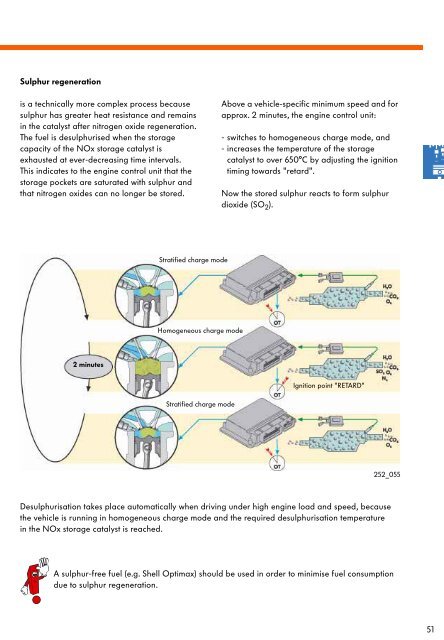Direct Petrol Injection System with Bosch Motronic MED 7 - Volkspage
Direct Petrol Injection System with Bosch Motronic MED 7 - Volkspage
Direct Petrol Injection System with Bosch Motronic MED 7 - Volkspage
You also want an ePaper? Increase the reach of your titles
YUMPU automatically turns print PDFs into web optimized ePapers that Google loves.
Sulphur regeneration<br />
is a technically more complex process because<br />
sulphur has greater heat resistance and remains<br />
in the catalyst after nitrogen oxide regeneration.<br />
The fuel is desulphurised when the storage<br />
capacity of the NOx storage catalyst is<br />
exhausted at ever-decreasing time intervals.<br />
This indicates to the engine control unit that the<br />
storage pockets are saturated <strong>with</strong> sulphur and<br />
that nitrogen oxides can no longer be stored.<br />
Above a vehicle-specific minimum speed and for<br />
approx. 2 minutes, the engine control unit:<br />
- switches to homogeneous charge mode, and<br />
- increases the temperature of the storage<br />
catalyst to over 650°C by adjusting the ignition<br />
timing towards "retard".<br />
Now the stored sulphur reacts to form sulphur<br />
dioxide (SO 2 ).<br />
Stratified charge mode<br />
Homogeneous charge mode<br />
2 minutes<br />
Ignition point "RETARD"<br />
Stratified charge mode<br />
252_055<br />
Desulphurisation takes place automatically when driving under high engine load and speed, because<br />
the vehicle is running in homogeneous charge mode and the required desulphurisation temperature<br />
in the NOx storage catalyst is reached.<br />
A sulphur-free fuel (e.g. Shell Optimax) should be used in order to minimise fuel consumption<br />
due to sulphur regeneration.<br />
51

















